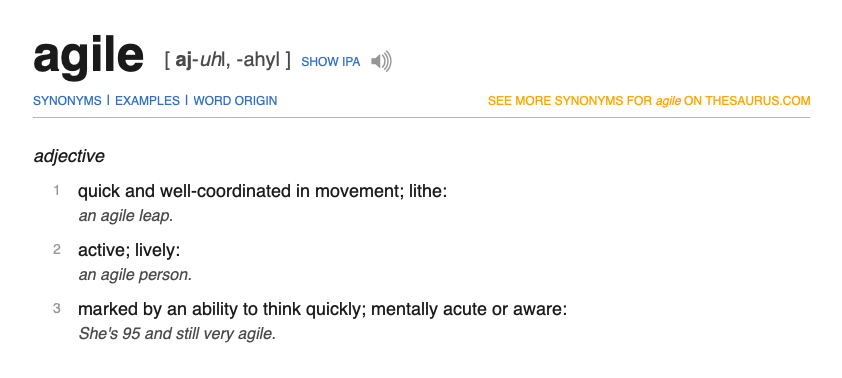If we were given a pound for every time we’ve heard the phrase – “we need our insight generation and decision making to be far more AGILE” we’d be millionaires. Well that’s not strictly true, we’d actually have a few hundred pounds I guess, but that’s not quite as sensational.
Either way, it got us thinking. What does it really mean to be AGILE in a research sense? From the stakeholders we’ve spoken to it is overwhelmingly about one thing. SPEED. Speed of decision making. “I simply don’t have the time to be waiting 6 weeks to get concept test results, I need to be making decisions quicker or my competitors will get there first”.

In principle we don’t have an issue with this. It’s a valid kick up the backside to the research industry and has sparked the growth of a highly successful research segment where technology allows all types of research programs to be turned around at the touch of a button. 1000’s of people can be questioned instantaneously and results spat out in a set of standardised charts before you’ve had a chance to make a cuppa.
But being agile can be risky
There are always compromises with agile approaches. They often ‘cut out the ‘middleman’ of the research professional, be that in the agency or a client side insight person. These people would typically be able to appraise the findings in the context of a deeper understanding of the customer and often have the research nous to spot if findings are a pile of codswallop. Do the people who receive and act upon these “agile” data sources have the right skills to appraise, understand and make the right decisions? In some cases, yes. But, worryingly, we are observing more and more cases where the answer could also be no. The quote below comes from a senior insight manager in a well known, global FMCG business that, in many peoples view, wrote the book on world class planning:
“10 years ago my business partners in the marketing and product development teams simply couldn’t avoid face to face contact with our consumers, predominantly through a broad variety of qualitative work. The recent shift to more “agile” techniques, both for reasons of speed and cost but also due to the growing availability of ‘big data’, has reduced that contact significantly. This is having a negative impact. Less contact means decision makers have less empathy, less empathy makes it harder for them to make good decisions using the more superficial data our agile techniques provide. Our new data tools are shallower and so is our underlying levels of empathy for our consumers”
Senior Insight Manager FMCG
This is pretty concerning, but it’s not surprising. If you look at the dictionary definition of AGILE there are some important words in there: active, lively, mentally acute. If an athlete doesn’t exercise, stretch, eat well they have little chance of remaining agile, even if they are given the highest spec kit to help them. Believe me, even with the world’s best climbing gear there is little chance I’m going to be scampering to the top of a rock face any time soon!

That regular dose of consumer/ customer contact is the core training and nutrition of a business decision maker. Without it we’re not really getting the most out of the other sources of insight, however high tech or agile they might be.
So what should we be doing?
Well, building a regular customer closeness programs is one idea (ahem – we all have mortgages to pay you know). But, to be very honest, that’s just one route you might explore. We would wholeheartedly endorse a whole range of activities, many of which can be done at zero cost – spend more time in the environments your customers spend time in, spend a few hours at lunchtime observing your customers, consume the media your customers consume, engage with your competitors products……. the list is endless. All that we advise is you do it regularly and you discuss and share what you learn and observe with your teams. Drop us a line and we’ll be happy to chat about some ideas. We’ve done a fair few and have learnt what makes these type of behaviours stick (or not).
Building a corporate culture that is truly interested in its customer will build a business that has better empathy for its customer. And it will be a business that is more AGILE, or at the very least better equipped to make good decisions in a more agile way.
Think of it as a spot of yoga for your organisation. The research equivalent of the downward dog.

Get out, stretch those limbs and get connected.

